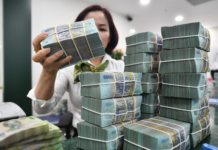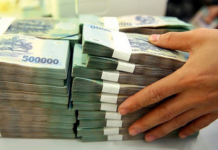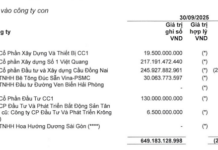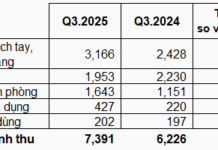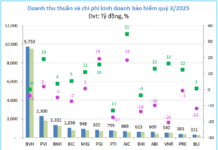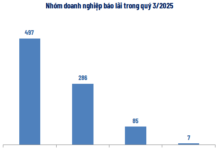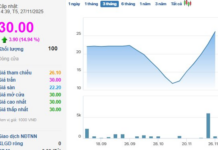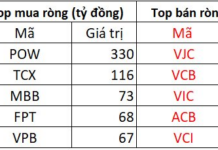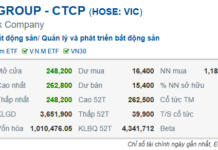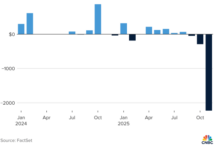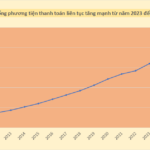Wage Increase Barely Keeping Up with Rising Cost of Living
The Ministry of Home Affairs has proposed a 7.2% increase in the minimum wage (equivalent to a rise of VND 250,000 – 350,000 depending on the wage region) from the beginning of 2026, according to a draft decree regulating minimum wages for employees. This annual proposed increase in the regional minimum wage is always eagerly anticipated by workers.

Authorities need to maintain price stability when wages increase so that workers can truly benefit. Photo: Nhu Y.
Ms. Nguyen Lan, a worker at the Dong Van Industrial Park (Ninh Binh), shared that living expenses, including food and rent, have been on the rise since the beginning of the year. Rent and tuition fees for her children have increased once every six months. Therefore, she is always happy to hear about wage increases.
“My husband and I are both workers in the industrial park, relying on our monthly wages. Living expenses, tuition fees, and rent have been gradually increasing, so the wage increase helps us offset daily inflation,” Ms. Lan said. “However, in the market, whenever there is news of a wage increase, vendors tend to raise their prices. I hope that this time, prices will remain stable so that we can truly compensate for the increased cost of living,” she added.
According to the latest survey by the Vietnam General Confederation of Labour, involving nearly 3,000 people in 10 provinces and cities from March to April 2025, most workers are struggling to maintain a minimum standard of living. Specifically, only 54.9% of respondents indicated that their income was sufficient to cover basic family expenses. Moreover, 26.3% had to live frugally, 7.9% could not make ends meet, and 12.5% had to take on additional work. This situation has forced workers to cut back on spending or borrow money (12.5% of respondents borrow money monthly, and 29.9% borrow periodically to get by).
In terms of dietary conditions, only 55.5% of workers can afford to eat meat or fish at every main meal, while the rest cannot ensure a proper diet, negatively affecting their health, productivity, and long-term quality of life.
Speaking to Tien Phong , Ms. Vi Thi Hong Minh, Deputy Director of the Office for Employers (VCCI), said that the regional minimum wage is the lowest level that businesses can offer to compensate for inflation. The minimum wage adjustment is based on the minimum standard of living for workers and their families, the relationship between the minimum wage and market wages, the consumer price index, economic growth rate, labor supply and demand, employment and unemployment, labor productivity, and businesses’ ability to pay.
“The increase in the regional minimum wage aims to offset inflation so that workers can afford their daily expenses. This proposed increase takes into account the living standards of the population affected by the regional minimum wage,” Ms. Minh explained.
According to the draft decree regulating minimum wages for employees working under employment contracts, the Ministry of Home Affairs has proposed a 7.2% increase (equivalent to a rise of VND 250,000 – 350,000 depending on the wage region) from the beginning of 2026. With this proposal, the minimum wage for Region I would be VND 5.31 million per month, Region II VND 4.73 million, Region III VND 4.14 million, and Region IV VND 3.7 million.
Preventing Price Hikes Following Wage Increases
For many years, whenever wages have increased, there has been a tendency for prices of goods to rise simultaneously. Talking to Tien Phong , Dr. Pham Thu Lan, former Vice President of the Institute of Workers and Trade Unions, said that the minimum wage increase aims to compensate for inflation for workers. To make this increase meaningful, authorities need to implement solutions to control inflation.
“There is a psychological factor at play when it comes to price hikes following wage increases. Meanwhile, the minimum wage increase is meant to offset inflation for workers. Along with the wage increase, authorities should control inflation by increasing the supply of goods and regulating price increases so that workers truly benefit from this policy,” suggested Dr. Lan.
Given the potential for multiple factors to put pressure on prices in the second half of 2025, the Price Management Department (Ministry of Finance) is coordinating with relevant units to flexibly manage prices, supporting the resolution of difficulties in production, business, and people’s lives.
According to economic expert Ngo Tri Long, wage increases are a significant issue for workers and society. While wage increases directly affect workers, they can also impact the overall price level if not properly managed.
Mr. Long pointed out the difference between nominal and real wage increases. Nominal wage increases refer to the amount of money workers receive monthly. Real wages are nominal wages compared to the consumer price index. When nominal wages increase faster than the consumer price index, workers benefit. However, if price increases outpace wage growth, workers are at a disadvantage.
“Wage increases are meant to reproduce labor power and motivate better work performance. However, we need solutions to control and prevent price hikes. Authorities should regulate the market, increase the supply of goods, and impose strict penalties on unjustified price increases,” Mr. Long recommended.
What is the Impact of Large-Scale Capital Injection on Economic Growth?
Hundreds of projects have just been launched with an investment capital of approximately VND 1.28 quadrillion. This injection of funds into the economy is expected to boost economic growth in the coming years.
“How Did Vietnam, a Poor Economy with High Inflation, Successfully Navigate and Emerge from Two Major Crises to Achieve Double-Digit Growth?”
“In a bold statement to the IMF, WB, ADB, WTO, and 650 foreign investors, Vietnam, a once impoverished nation, declared its openness to the world. As per Professor Nguyen Mai, a renowned economist, Vietnam pledged to amend its constitution and protect foreign investors’ assets and interests. This courageous declaration marked a significant turning point for the country’s economy, positioning Vietnam as an ideal destination and a second home for FDI businesses.”









